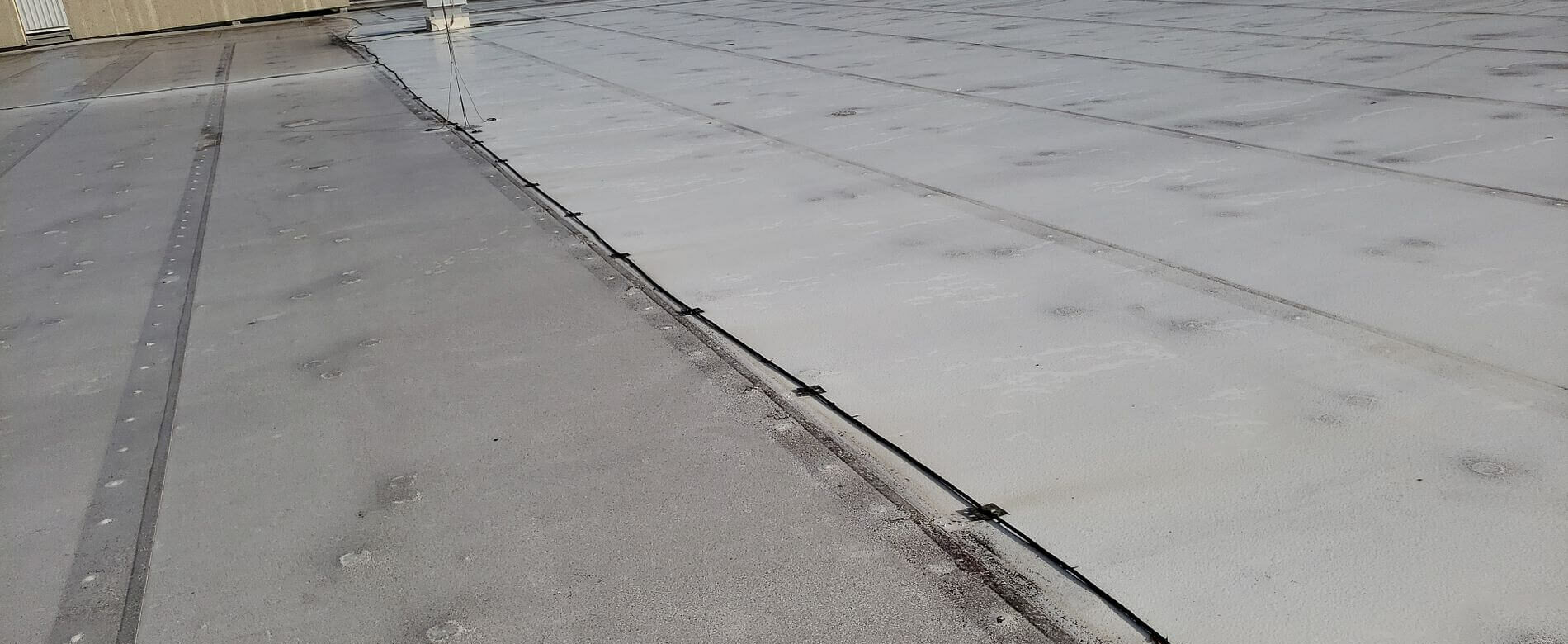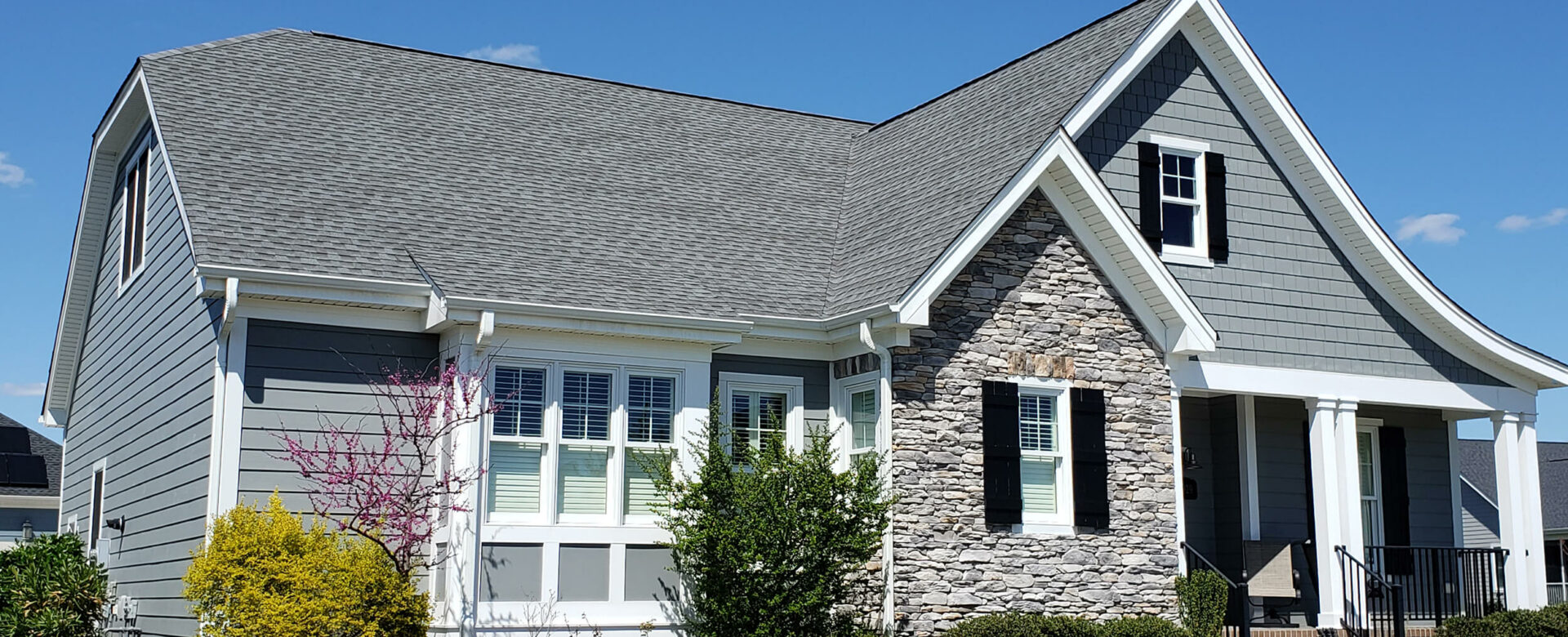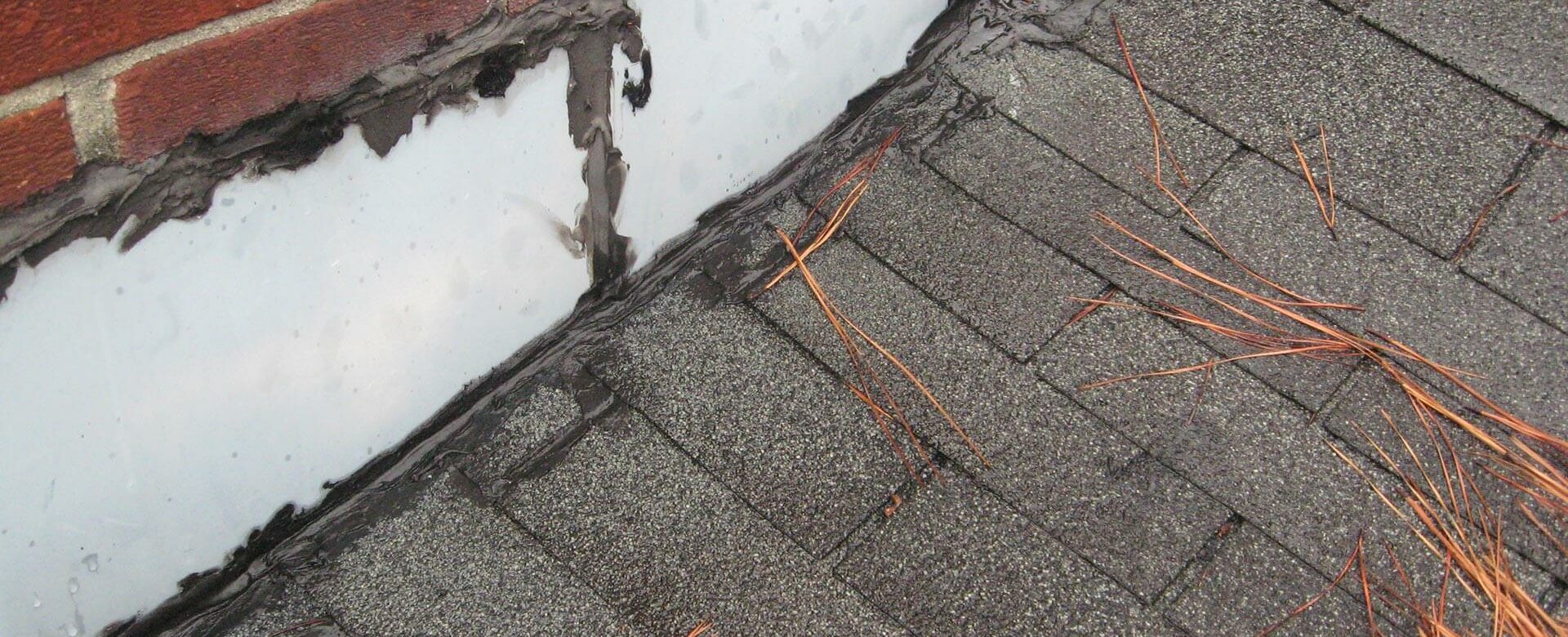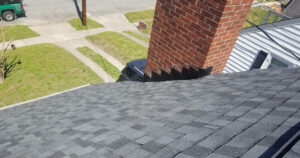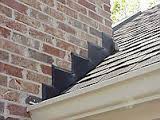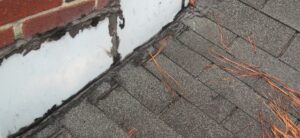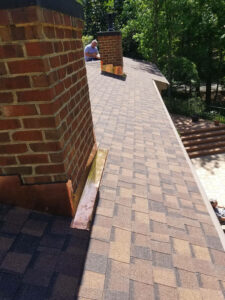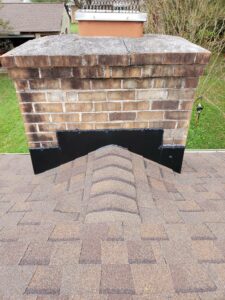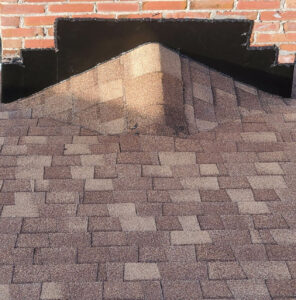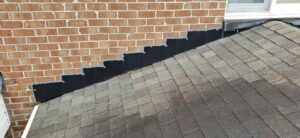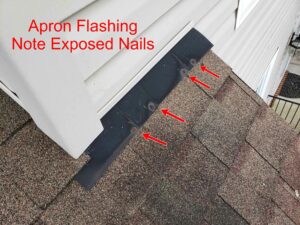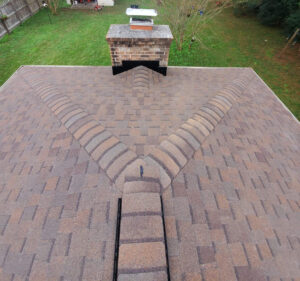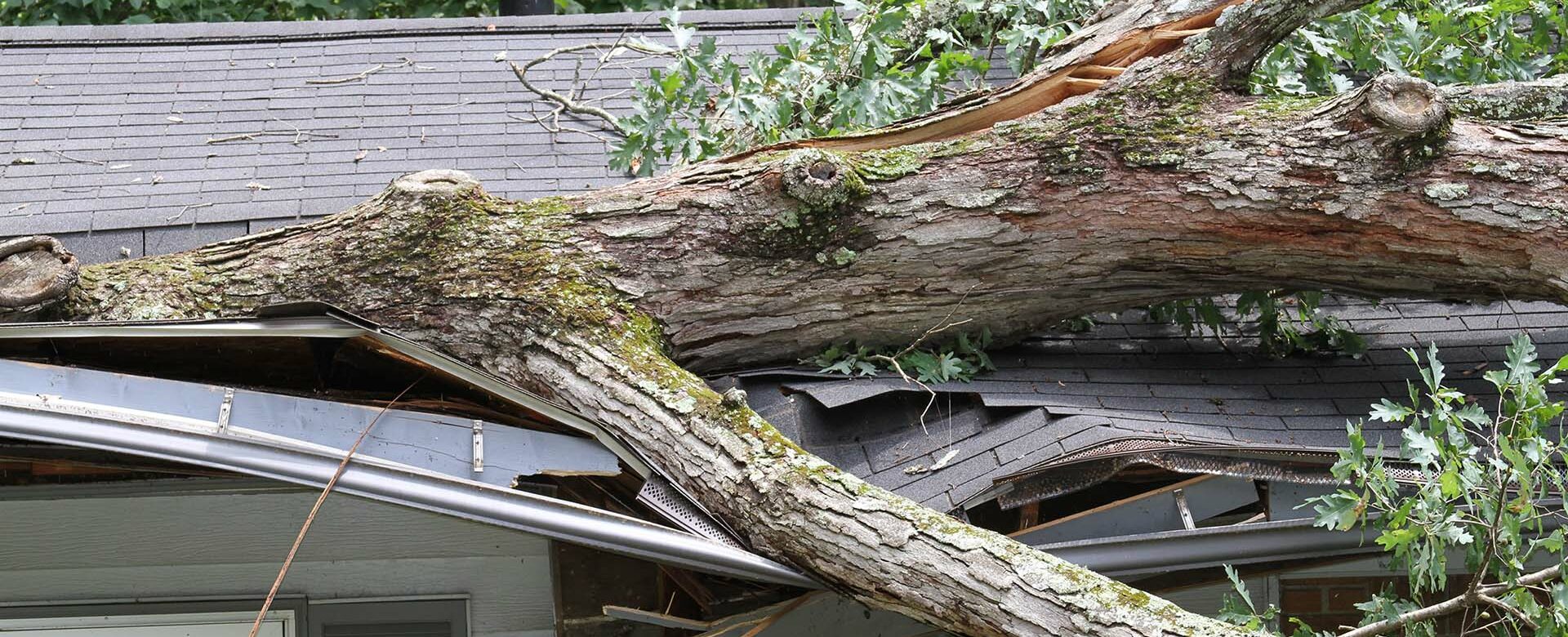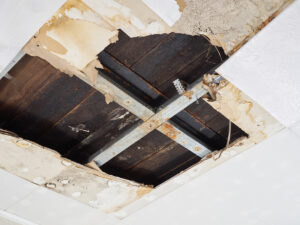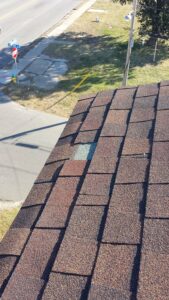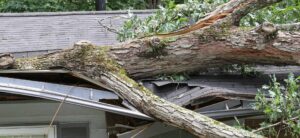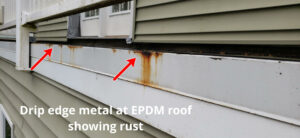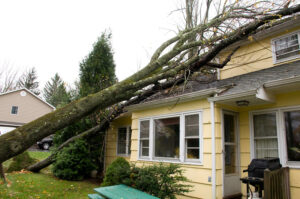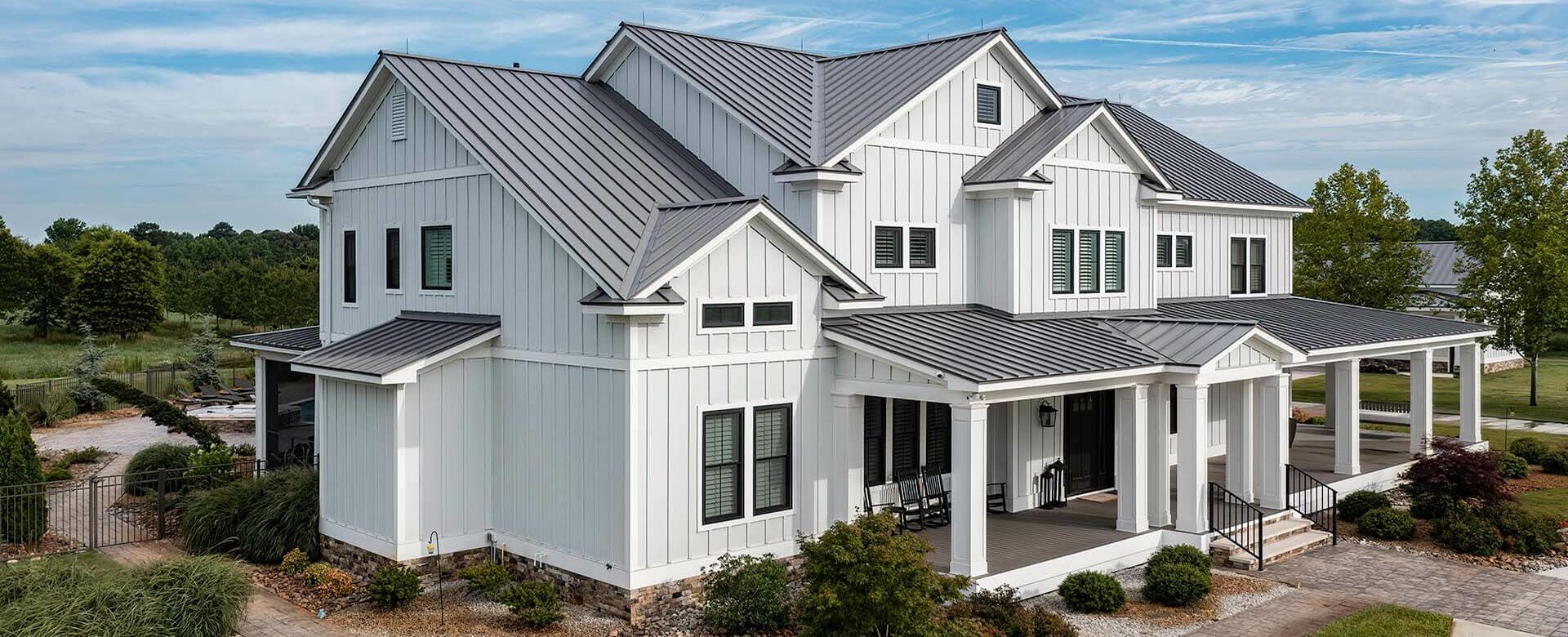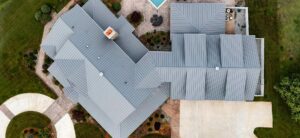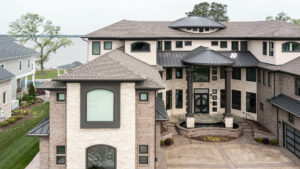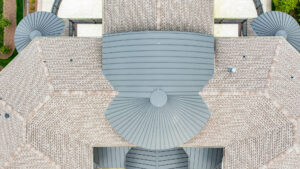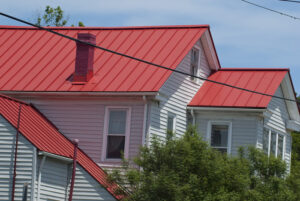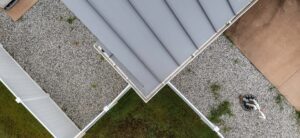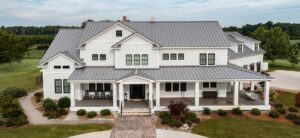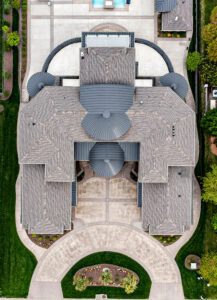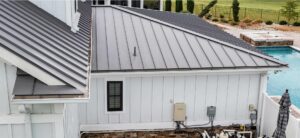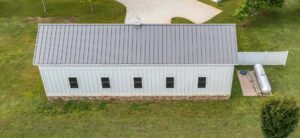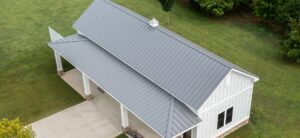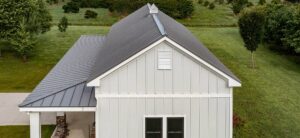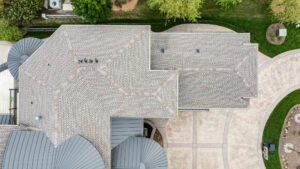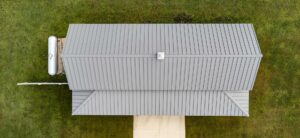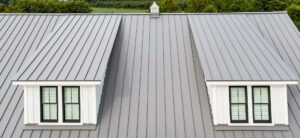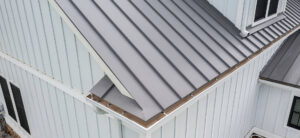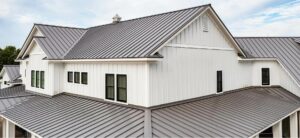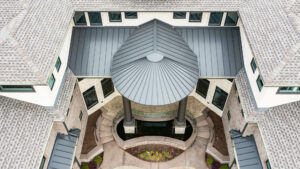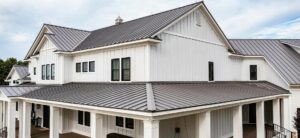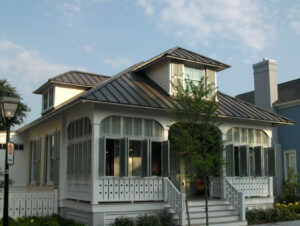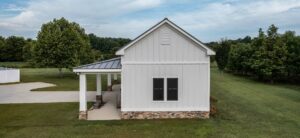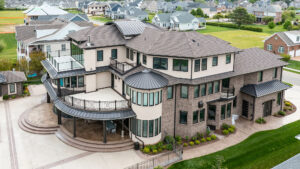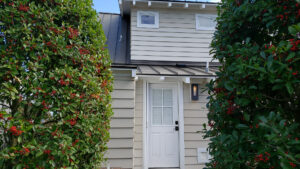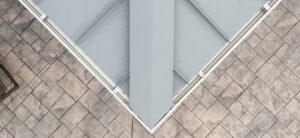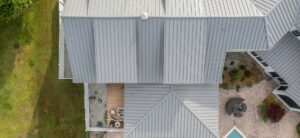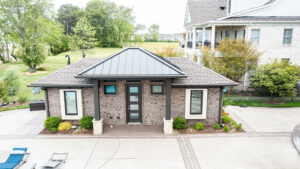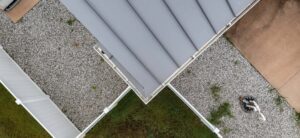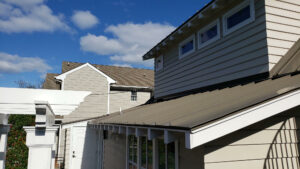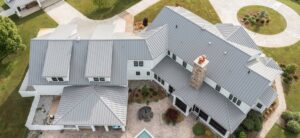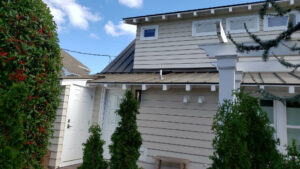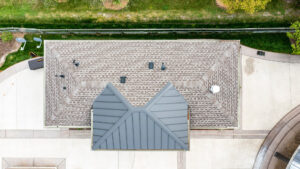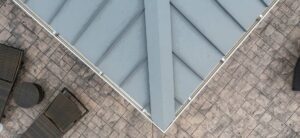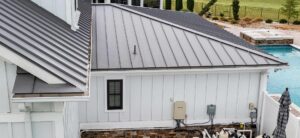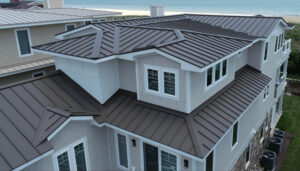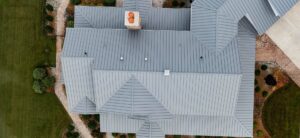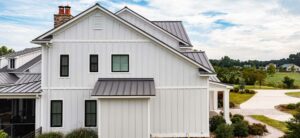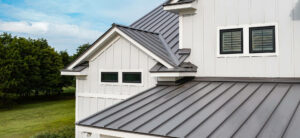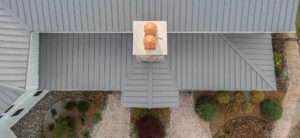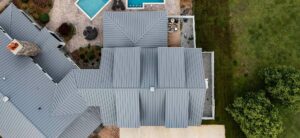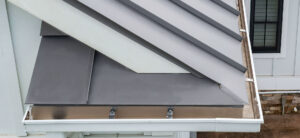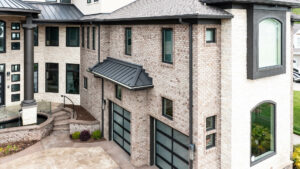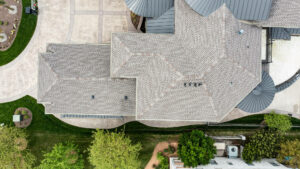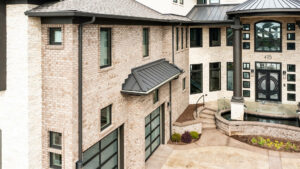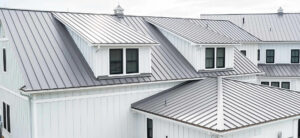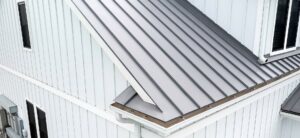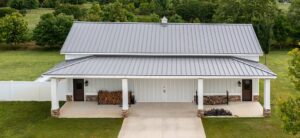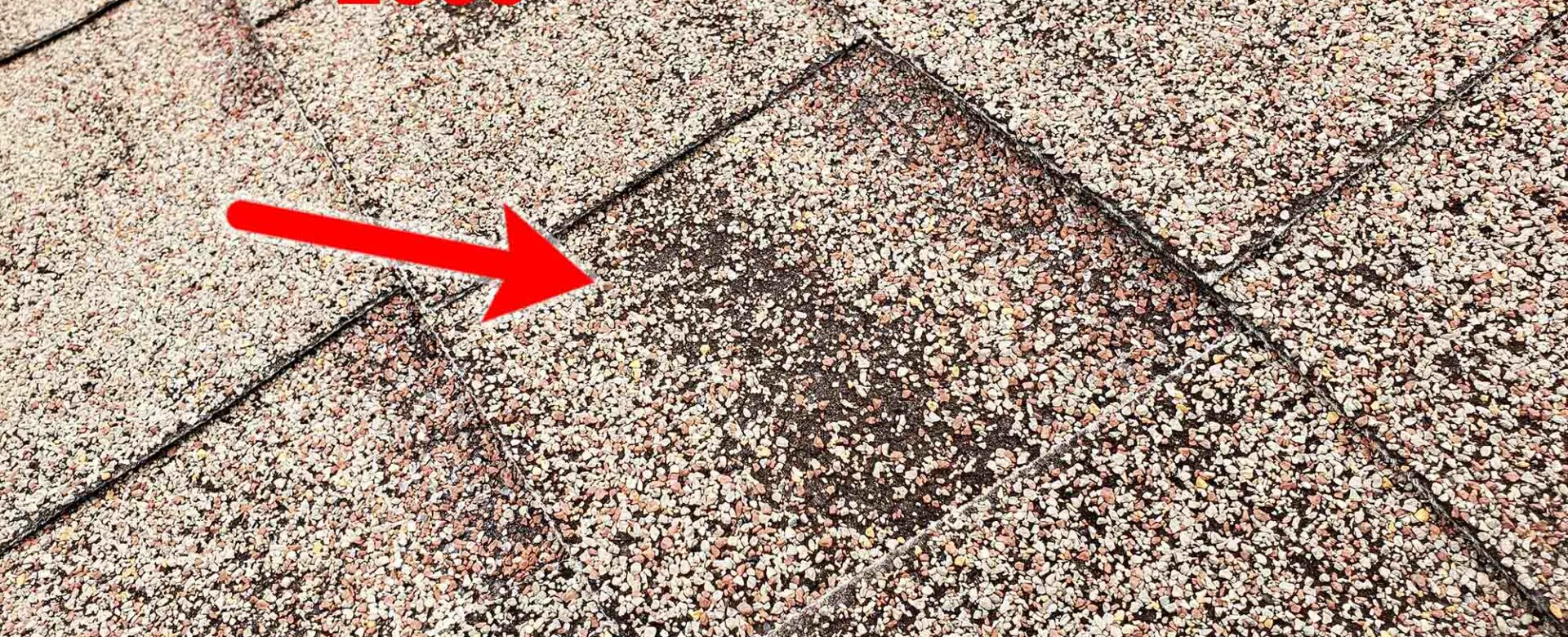On this commercial PVC membrane, notice the clean side is downhill and dirty side is uphill. When water runs across the copper cable it actually picks up tiny particles that distribute across the roof to prevent mold and algae growth, also inhibiting dirt accumulation. But these cables are actually a series of lightning rods, so if lightning strikes the building, its purpose would be to absorb the electrical charge and direct it to a grounding source to minimize damage to the building. This is relative to shingle roofing because the granules are designed with a copper core, which allows shingles to have an algae resistant quality.
Does Your New Roof Have a Warranty?
When you invest your hard-earned money into your home, especially a sizable investment for something like a new roof, you want to know that you’re protected.
It’s important to understand, when pricing out a new roof and receiving quotes from roofing contractors, what the elements of a roof warranty include. There are a few different things to consider and questions to ask of anyone you’re considering hiring.
Roofing Material Warranties
Most roofing materials come with their own manufacturer warranty. For asphalt shingles, it’s common for manufacturers to provide a 25–30-year warranty, although some do offer longer or “lifetime” warranties. Many metal roofing materials are covered for up to 50 years or longer. The important thing to remember here is that their warranty only covers the material, not labor and not the cost of disposal. Some companies offer enhanced coverage you can purchase that will pay for a full replacement including workmanship for a certain period of time, but those warranties can be costly and require additional certifications and documentation by the contractor.
When receiving quotes on a new roof, ask questions about the materials and manufacturers each contractor uses, and what the warranties look like for each. A good roofing company will know their chosen manufacturer warranties inside and out and have insights about what will be best for your situation, home and location. Manufacturers will only honor warranties on their materials if they have been installed correctly and by a licensed contractor, so make sure you go with a reputable company.
Roofing Contractor Warranties
The other side of roofing warranties is the coverage that your roofing contractor provides to cover their own workmanship. These can vary widely from company to company. Because of that, it’s a good idea to get all of your quotes in writing along with a printed copy of their warranty coverage details. A workmanship warranty will typically cover damage that is caused by improper installation. Make sure the company also covers any materials that may be needed to fix the damage incurred.
At Andrews Roofing we provide a 10-year workmanship warranty on all of our shingle installs, provided we are the primary contractor to the client. This is longer than the industry norm for workmanship warranties. In addition to covering our work on new roof installations, we also warranty any repair work we do on a roof that we installed. We’ve been working in the Hampton Roads region for years, and our reputation in the community illustrates how we stand behind our work. Make sure that whoever you end up hiring has a good standing and reputation in your own community. Check online reviews and ask around with your neighbors. You can even contact the Better Business Bureau or licensing board of your state to make sure the company is in good standing.
Protecting Your Roof Warranty
It’s critical that you understand the requirements of your warranty to avoid rejected claims. If a leak or other damage is incurred, it should be promptly reported to the warranty department so corrective measures can be made as soon as possible. If you do have damage or issues, go back to your original roofing company. Unless they have proven themselves to be completely untrustworthy, it’s best to have continuity in the warranties and work. And finally, do not forget to register your warranty with the manufacturer after the work is completed if it is required. Some warranties do not require formal registration and some do, so it’s important to review your warranty package carefully when you receive it. For enhanced and upgraded warranties, the contractor may have to submit paperwork on your behalf with additional documentation.
We Stand Behind Our Work
We stand behind the work and the materials we use at Andrews Roofing. We’ve been in the business long enough to know which manufacturers do the same, and that’s who we use and recommend to our clients. Our exceptional workmanship warranty and reputation in the Tidewater Region can help you have confidence in your home investment for many years to come. Contact us today for a quote on your new roof.
Why Good Flashing Is Critical for Your Roof
When we talk about roofing repairs and replacements, people typically just think about shingles or other types of exterior roofing materials like metal, cedar shake or clay tile.
But there are many critical pieces that go into a good, solid roofing system, and one of them is flashing. Flashing is more important than people think, and improperly installed, damaged or missing flashing is one of the most common causes of roof leaks.
What is flashing?
When a roof plane meets a vertical surface, shingles and other roofing materials can’t be used to protect those parts of the roof. Instead, flashing is installed around vertical roof features to direct water away from these critical areas. Roof flashing is a thin metal material that comes in large sheets and is cut, molded and layered to fit where it is needed. It may also be made out of a plastic membrane for some applications or you may see PVC used at penetrations as pipe collars, sleeves and other fittings that function as flashing.
How does flashing work?
Without flashing, water could penetrate between the crevice of say, a shingle and a chimney. Flashing ensures that the water runs back over the roofing material, down the roof plane and off the house, hopefully into a clear and clean gutter. Other areas where flashing may be used includes vents, skylights, dormers, and sometimes even between the edge of the roofline and a gutter system.
What is flashing made of?
The materials used for flashing has changed over the years, from lead-coated materials to safer and more durable types of metals. This includes aluminum, copper and galvanized steel. Depending on the building codes where you live, a roofing contractor may have to use a specific material. While we typically use aluminum flashing on residential installs, the material itself is dependent on the specific roof and situation.
When should I replace or repair flashing?
If your home is experiencing a leak, and it does not appear to be from missing shingles, punctures or other damage, it may be time to check the flashing. Check the areas we discussed above to see if any of these issues have occurred:
- Holes, dents or bending
- Corrosion or rusting
- Missing nails or loose nails
- Loose or missing flashing
If you spot any of these issues, it’s time to call in a qualified roofing professional. Replacing flashing yourself is dangerous and if done incorrectly, can cause even more damage to your roof and ultimately the interior of your home.
When having your roof replaced, it’s a good idea to have the flashing replaced at the same time. Some areas may be able to be reused, but to ensure a watertight seal and a lifespan equivalent to your new roof material, full replacement is likely worth the minimal extra investment. Your existing roof flashing materials may also not be up to current code, in which case a roofing contractor will be obligated to replace it. Alternatively, it’s very possible that when you are experiencing a leak caused by flashing that only the flashing will need to be replaced, and that a full roof replacement is not necessary.
If you are having issues with your roof’s flashing, or have a leak you haven’t been able to identify the cause of, give Andrews Roofing a Call. We are experienced in the specific issues Hampton Roads homeowners encounter, especially during storm season. Contact us today.
Common Roofing Storm Damage
If you watch the local news or even just tune in for the weather forecast, you know that we’ve reached peak hurricane season and that the tropics have been very active thus far.
Fortunately, the Mid-Atlantic coast including Southeast Virginia and Hampton Roads have been spared from any direct hits. But there are still two more months of hurricane season, and now is the time to be prepared for anything that may come our way. Not to mention that as soon as hurricane season is over, nor’easter and winter storm season will be upon us.
When it comes to your home and your home’s roof, there are plenty of things you can do in advance to avoid certain types of damage during storm season. But there are some things you simply can’t prevent from happening, and being responsive after the fact is the best you can do. Here are a few common types of roof damage to keep an eye out for as we weather hurricane season this fall.
Tree Damage
Tree damage isn’t always as obvious as an entire tree crashing through your roof and into your home. Some tree damage can go unnoticed until it causes interior damage – days, weeks or even months later. A stray limb with enough wind and force behind it can cause shingles to fly off, roof sheathing and decking to be pierced and make your roof vulnerable to leaks.
Tree damage can even come from overhanging branches that simply rub along shingles and cause unwanted wear and tear. It’s always a good idea to keep low hanging or potentially destructive branches trimmed back from the roofline where possible.
After a storm, visually inspect your roof as well as you can from the ground to see if any limbs, branches or even leaf buildups can be seen. If so, they should be removed immediately and the roof should be inspected to ensure no damage was caused. If damage was caused, a roofing contractor will typically be able to do a repair confined to that area without a major overhaul of your roof.
Loose or Missing Shingles
Perhaps the most common damage after a storm is loose or missing shingles. While it may not seem like a big deal if one or two shingles come off, their absence makes the shingles all around that area more susceptible to blowing off, and jeopardizes the roof sheathing beneath. Depending on when and how your roof was installed, the material manufacturer or installer may have specific warranties to cover shingle replacement. In any case, the shingles should be replaced as soon as possible to prevent further damage.
Loose or Missing Flashing
Flashing is the metal sheets that are used in roofing around joints in a roofline and around other roof penetrations such as pipes, chimneys and vents. They play an important role in protecting your roof decking and if jeopardized, major interior damage can occur. Loose flashing can actually cause quite a bit of damage to the rest of your roof, tearing up or removing shingles around it, especially in a wind event.
Missing flashing can allow water intrusion and will also make it easier for nearby shingles to be blown away. Some flashing you may be able to visually inspect from the ground, but if you have reason to believe that flashing may be loose in spots that you’re not able to inspect from the ground, call in a qualified roofing contractor to inspect for you – don’t risk causing damage to yourself to find damage on your roof.
Clogged or Broken Gutters
Particularly if you live near a lot of trees, storms can cause debris to fly off of nearby vegetation that can eventually land right into your gutters. This debris will cause your gutters to work less effectively, which means water will build up and potentially seep up underneath your shingles and sheathing, causing damage to the roof decking below, often seen as dark water spots in the corners and along the top of the walls in your home. Ideally, have your gutters cleaned before storm season so that they are cleared and ready to carry all that stormwater away from your home. But it’s also a good idea to check on them after a storm and make sure nothing has caused any clogs or damage to the gutter itself.
Broken or loose gutters are also common after a storm, and if you see evidence of that, call in a licensed contractor to fix the problem before the next rain event occurs. Broken gutters can funnel water into places it should not go including near your home’s foundation and onto walls and windows, causing even more damage. If you don’t have gutters, or your home’s gutters need to be replaced, you may also want to consider installing a Rapid Rain ™ gutter system which is designed for high capacity that comes with living in a storm prone area.
Contact a Local Roofing Contractor
This hurricane season, if your roof sustains any damage during a storm, contact Andrews Roofing. We are locally owned and operated and we are highly experienced in the issues that are unique to the Tidewater region. We know what to look out for and how to best fix and repair an issue to withstand future weather events.
Metal or Shingle Roof: What’s Right for Your Home?
Metal roofs have become increasingly popular in residential structures in recent years, whereas asphalt shingles have been the de facto material of choice for decades. There are plenty of good reasons to consider metal roofing, but is it right for your own home?
Here are a few things to consider before replacing your roof with metal.
Durability and Lifespan
Metal roofs have a lifespan of 50 or more years – twice the length of a traditional asphalt roof. In addition to lasting much longer, they are also more durable. If installed properly by a licensed roofing contractor, some metal roofs can sustain up to 140 mile per hour winds. This is a serious benefit in a hurricane and storm-prone area like Hampton Roads. For homes in areas prone to wildfires, metal roof systems are less likely to ignite or catch fire from a spark or rouge flame.
Sustainability
When replacing your roofing system, there are some things to consider about the environmental friendliness of your choices. One is the material itself. In the case of metal roofs, the material is usually 25-95% recycled content, and metal roofs are themselves 100% recyclable. There’s also the energy efficiency of your roof. Metal roofs reflect UV rays, which can reduce the temperature of the surface and can result in a 10-25% reduction in cooling costs for your home, saving energy and fossil fuels.
Affordability
While there are great benefits to metal roofs, and while their popularity has increased, they are still significantly more expensive than traditional asphalt shingles. Depending on the exact type of metal materials used, it may cost two to three times more than an architectural shingle replacement. Metal roofs can save you money over time for the reasons mentioned above, but you should consider how long you plan to live in your home and whether you will be there long enough to get a return on your investment.
Sound
While modern building methods do offer metal roofs a bit more insulation from sound than in the old days, they are still louder than a traditional roof. Some people love the sound of rain on a metal roof, while others may find it bothersome over time. There is nothing definitively good or bad about this aspect of metal roofs, but it is something to keep in mind when making the decision.
Snow
For areas where snow is common or in commercial situations, metal roofs will typically need snow guards. These little metal semi-circles or horizontal strips of metal keep snow from falling off in large clumps onto someone or something below. Even if you’re not in a snow prone area, you will need snow guards on steeply pitched roofs such as front porches and porticos. A qualified roofing contractor who is experienced with this material and installation will know the best way and the best places to install snow guards on your metal roof.
Style
Manufacturers of metal roof systems have made major advances in the style and color range of metal roofing. In some cases, metal roofs can even look like traditional shingles from a distance. For the most part, though, metal roofs have a distinctive look and style which may or may not compliment your home. Some manufacturers have tools on their websites where you can visualize what different roof materials and colors would look like on a home similar to yours. Or you may just want to take some time to search the internet for photos of homes with different types of metal roofs.
An experienced roofing contractor can also assist you in visualizing and choosing the appropriate material. At Andrews Roofing, we’ve completed many homes with metal roofing, and one of the approaches that has become popular with our clients is to mix roofing materials. The primary roof of the home may be architectural asphalt shingles, with small overhangs, porches or dormers using a complimentary metal material. This look works great on Craftsman style homes and more modern designs. It also gives the home the unique and high-end look of metal without as much of a cost increase.
If you are considering replacing your roof with a new metal roof, or if you just have questions about what roofing material is right for your reroofing project, contact Andrews Roofing. We’ve worked with clients in the Tidewater region for decades, and know the best materials, approach and application for all types of roofing systems.
How to Know When Your Roof Needs a Checkup
They say an ounce of prevention is worth a pound of care, but that doesn’t just apply to your physical health. The same could be said for anything you maintain, including your house and its major systems such as your roof. While there’s no getting around the fact that a roof will eventually need to be replaced, there are many things that can happen over the course of a roof’s lifespan that should be serviced, repaired and maintained. This is especially true in areas prone to severe weather such as the Hampton Roads region.
But how do you know when you should call in a professional roofing contractor? Here are a few things to keep an eye out for to help extend the lifespan of your roof.
Curling, cracking or buckling shingles are a tell-tale sign that your roof needs some attention. You may also notice asphalt granules in your gutters, which have deteriorated from damaged shingles. This doesn’t mean you need an entirely new roofing system! While this type of roof symptom can sometimes be a sign that a roof has reached the end of its serviceable life, it can also be an isolated incident that simply needs to be repaired or patched.
While it may not necessitate a total replacement, shingles that are damaged or worn should be a high priority on your home to-do list. Just a few curling shingles can allow water to penetrate your roof causing leaks, mildew and other interior damage.
Speaking of interior damage, dark spots on your ceiling or walls also signal that it’s time to have a roofing professional come out and inspect. Even if you don’t see a hole or missing or damaged shingles from the outside, the leak may still be the result of a failure in your roofing system such as loose or missing flashing, backed up gutters or damage that simply isn’t visible from the ground.
Dark spots indicate that moisture has penetrated your roof, the sheathing, decking, and potentially attic flooring. These are serious signs that should be attended to as soon as possible by a professional to ensure additional damage does not occur and that harmful mold and mildew do not start to grow.
Moisture in your attic may also be a sign of problems with your roof as well as your insulation. If you find that the insulation, wood, flooring, ductwork or other items in your attic seem damp, it may be caused by a lack of proper ventilation and/or unsatisfactory insulation. But these issues, over time, can also affect the health of your roof by causing water damage to decking from the underside. An ideal attic temperature is close to that of the temperature outside. This prevents condensation, which is often the cause of interior moisture damage. A licensed professional contractor will need to address these issues if you find them.
Of course, sometimes all of these things indicate that a roof has simply reached the end of its lifespan and needs to be replaced. Most modern asphalt shingle roofs have a lifespan of 20-30 years. In the cities of Virginia Beach and Chesapeake and across the Tidewater region, many homes and large neighborhoods were constructed in the 1990’s, making them the age now to need total replacement.
A qualified roofing company can provide you with a roofing checkup to help you determine whether a repair or total roof replacement makes the most sense for your home and budget. At Andrews Roofing, we provide professional evaluations, customized quotes and affordable financing options as well. Whether you think your roof needs an ounce of prevention or a pound of care, we can help. Contact Andrews Roofing today.
